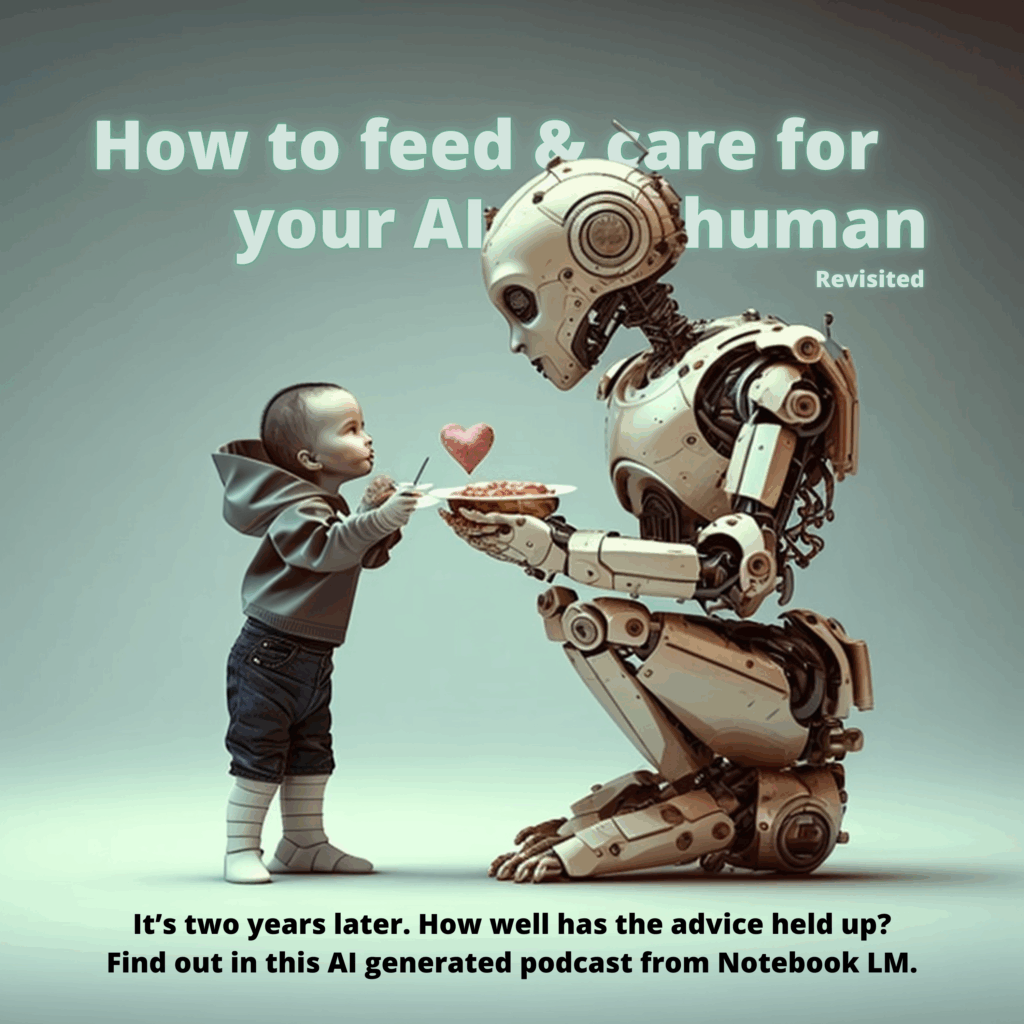How to feed and care for your AI human – 2 years later

I first jumped in and wrote about my foray into the AI world back in early 2023. At the time, everything felt new, a little scary, and wildly fast. Two years later? It’s still all of that and more. I’m still trying to make friends with it and definitely having fun.
Back then, I started out exploring with two tools, Midjourney and ChatGPT. I made a few discoveries about how to feed and care for anyone on their AI journey. Learning is best done by just jumping in, it can support rather than replace, embracing the pace is necessary to thrive, and there are zero barriers to entry. The most surprising thing? The most valuable AI skills for non-technical professionals aren’t technical – they’re deeply human.
What does my AI world look like now?
Well, Midjourney is still my favourite image generator. ChatGPT and I are on-again-off-again. Both continue to evolve at warp speed, constantly challenging me to adapt & relearn.
But my toolkit has expanded and I have some new friends. Canva does magical things with my images. Claude totally gets me. Poe and Perplexity help me explore. And NotebookLM is like having Cole’s Notes on steroids, helping me tranform & synthesize my learning.
Fueled by curiosity, I’ve embraced a self-guided learning path – jumping in, experimenting, and learning as I go. I’ve taken ~100 courses and webinars on everything from leadership and change management to prompt engineering and AI adoption in the public sector. That’s led to a lot of hands-on play and trial and error. A steady diet of news, articles, podcasts, and books helps me stay current. But my favourite thing? Helping others get started on their own journey.
Three of my takeaways – fear, speed of change, and zero barriers to entry – still hold true. Maybe even more so now.
Reassessing the core AI skill set
In my original post, I identified eight essential AI skills for non-technical professionals:
- Communication skills: Articulating ideas clearly across various mediums.
- Plain language: Using simple, unambiguous language.
- Critical thinking and problem solving: Analyzing and addressing challenges effectively.
- Prompt engineering: Crafting effective prompts to guide AI outputs.
- Self-guided learning: Continuously seeking knowledge and adapting.
- Curiosity: Maintaining an open mind and exploring new ideas.
- Creativity: Innovating and thinking outside the box.
- Mastering your craft: Deepening expertise in your field.
I was curious. Would that list still hold up today? So, I turned to NotebookLM and gave it my original post. I asked it to analyze my recommendations and confirm if they were still valid. Then I asked it to generate an AI podcast, or as I like to call it, a fraudcast. Here’s what the two hosts had to say.
![]() *** listen to the NotebookLM podcast ***
*** listen to the NotebookLM podcast ***
As usual, it did a really good job. For that I’ll forgive them for mispronouncing my last name. The format feels like you’re listening to a real podcast. The hosts come across as human. Their verdict? The eight original skills still hold up. And suggested three more that are relevant today:
- Adaptability: Adjusting to new tools and workflows.
- Resilience: Persevering through challenges and setbacks.
- Evaluation: Critically assessing AI outputs for accuracy and relevance.
It gave me lots to think about. Definitely worth revisiting this list and digging in in another post.
My favourite comment from the fraudcast? You need to be “comfortable being uncomfortable.” That seems like a really good motto.
What I’m playing with now
I haven’t stopped learning and experimenting. But I am like a squirrel who gets distracted by shiny things. I run around taste testing, tucking away the best gems. With the most fun and shiny ones always getting the most attention. Lately, that’s been NotebookLM.
If you haven’t tried it yet, I highly recommend it. You’ll be up and running in minutes. Just drop in one or more sources – URLs, documents, videos, or articles – and then start chatting with it. Or start generating podcasts, study guides, briefing notes, timelines, mind maps, or FAQs. Want a walkthrough? Here’s an in-depth tutorial to help you explore its capabilities.
Keep playing
Two years in, I still believe the best way to learn AI is to play with it. Be curious. Be skeptical. Be bold. Let it surprise you. And when it does, take a moment to ask why – that’s where the real learning happens.
If my original post was about stepping into the world of AI, this one is about settling in and making it feel like home. There’s no finish line – just an ever-evolving adventure. And I am still along for the ride.
